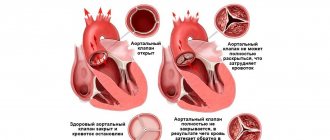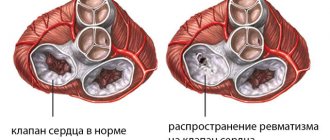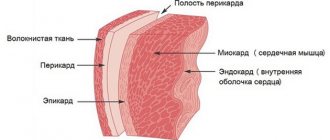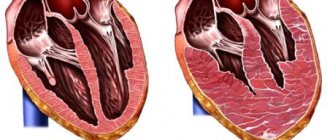Kinds
In most cases, the development of combined defects is observed, extending to the 2nd and 3rd valves. Unlike local ones, they appear much more often. They develop under the influence of stenosis or insufficiency and aggravate the clinical picture with additional symptoms and hemodynamic disturbances.
Combined type mitral disease
This is the most common pathology of the valves, in which its function is disrupted, and the opening that transfers blood from the atria to the left ventricle becomes stenotic.
In this case, systolic and diastolic murmurs are heard. Valve insufficiency is characterized by a weakening of the first heart sound.
If the stenosis is pronounced, then the tones are clearly heard and a weakening of the pulse is observed.
In a pathological process accompanied by valve insufficiency, blood pressure indicators do not change. Difficulties often arise in identifying the problem due to:
- Enlargement of the organ to the left side. This happens not only if the left ventricle has enlarged, but also if it has shifted under the pressure of the enlarged right one.
- The presence of upper murmurs is observed not only with valvular insufficiency, but also with other pathologies.
Therefore, a detailed examination is necessary to make a diagnosis.
Combined aortic heart disease
It is rare to encounter a combination of valve insufficiency and narrowing of the aorta. The development of aortic insufficiency occurs under the influence of syphilis and infectious diseases that cannot be accompanied by stenosis.
Narrowing of the mouth and dysfunction of the aorta occur with cardiac rheumatism. In this case, the valve is usually affected rather than the aorta itself. This type of pathology is accompanied by upper and lower noises, which are noticed during auscultation. Only two noises can reveal the presence of stenosis.
When the valve functions abnormally and there is noise, stenosis makes the symptoms of the pathological condition less pronounced. The disease is characterized by a decrease in upper pressure and a reduction in pulse.
Mitral-aortic disease
With this disease, combined heart defects are observed, in which two aortic or mitral defects develop simultaneously. The development of mitral and aortic stenosis occurs under the influence of rheumatism. Their deficiency causes rheumatic endocarditis.
When aortic valve insufficiency predominates, the pulse quickens and the pressure rises. If there is stenosis, then the symptoms will be moderate.
With severe aortic defects, an enlargement of the left ventricle is observed. The predominance of mitral disease is accompanied by an enlargement of the left atrium and right ventricle. Defects resulting from rheumatism are usually diagnosed in older people.
Combined mitral heart disease
Combined mitral heart disease (mitral disease) is an acquired heart defect that combines atrioventricular valve insufficiency with stenosis of the left atrioventricular orifice and is manifested by corresponding disturbances in intracardiac hemodynamics. Combined mitral heart disease occurs in cardiology much more often than isolated mitral regurgitation or mitral stenosis.
With mitral heart disease, there may be a predominance of stenosis of the orifice or valve insufficiency, or there may be approximately the same combination of stenosis and insufficiency. In this regard, mitral disease is distinguished with moderate stenosis and significant insufficiency; mitral disease with significant stenosis and moderate insufficiency; mitral disease with significant stenosis and significant insufficiency.
Characteristic symptoms
Combined heart disease manifests itself depending on how much the pathological process has damaged the valve. Initially, the pathology has no symptoms. As the disease progresses, a person suffers from:
- shortness of breath;
- cough;
- heart rhythm disturbances;
- swelling of the lower extremities;
- fatigue;
- confusion and fainting;
- tinnitus;
- heaviness and pain in the heart area. The pain may be aching and dull.
Most patients complain of a severe cough with streaks of blood in the sputum.
During the examination, the doctor notes that the skin has turned pale, the lips and nasolabial triangle have turned blue due to insufficient blood supply. If histamine-like substances are released in large quantities, the cheeks become covered with a thick blush.
The duration of the latent period from the onset of pathology to the appearance of clear clinical manifestations can be several decades.
Symptoms of combined heart disease
If the patient has a combined mitral-aortic defect, and mitral stenosis dominates, then the symptoms of the disease will be as follows:
- Cyanosis of the nasolabial triangle;
difficulty breathing; - fast and irregular pulse;
- cough, sputum streaked with blood;
- toes and hands, cyanotic lips, butterfly-shaped blush on the cheeks;
- in case of decompensation - pulmonary edema.
If aortic stenosis is more pronounced, then the course of the disease is favorable, the period of compensation is quite long. If aortic insufficiency is more pronounced, then patients are bothered by dizziness, fainting, and persistent headaches are often observed.
When the aortic valves are damaged together with the mitral and tricuspid valves, the skin color of patients is cyanotic, the neck veins are pulsating and swollen, and hemodynamic disturbances develop in the early stages of the disease. Blood pressure is usually low, the liver is significantly enlarged, and fluid accumulates in the chest and abdominal cavity.
Diagnostic methods
Combined heart disease is a pathology that can lead to death. Therefore, at the first manifestations, you should consult a doctor. To determine disorders, a number of diagnostic studies are prescribed.
First of all, the patient should undergo a physical examination. The doctor asks how the patient feels during and after physical activity, and whether there is a history of rheumatic or other diseases that can cause the defect.
During the examination, the following is revealed:
- paleness of the skin;
- vascular pulsation;
- swelling and shortness of breath;
- heart murmurs.
Specialists also evaluate the size of the liver. The patient must donate blood and urine for laboratory testing.
Also, to identify a combined defect, the patient is prescribed:
- electrocardiography;
- daily ECG monitoring;
- phonocardiography;
- magnetic resonance imaging;
- radiography and rheumatic tests.
It is difficult to make a diagnosis if a combined defect is suspected, since the clinical manifestations are layered.
Using instrumental examination methods, hypertrophic changes in the heart muscle and rhythm disturbances are detected. A phonocardiograph allows you to detect the presence of noise and corresponding tones. X-ray shows stagnation of blood in the pulmonary vessels and the presence of enlarged myocardium. Sometimes there is a need for sounding, venography, aortography.
A detailed examination will reveal the presence of a defect and the severity of the development of the pathological condition.
Ultrasound examination of the heart and Doppler sonography can accurately confirm the diagnosis.
Treatment
Combined heart disease is a pathology that does not have clear instructions for its elimination. For each case, individual options for eliminating the problem are selected. If there is a narrowing of the valve, then the need for surgical intervention appears in the presence of the slightest symptoms of the disease. Regurition also requires surgical treatment if obvious signs are present.
Also read: Causes of effusion pericarditis
General therapeutic methods
Treatment consists of eliminating the cause of the defect. Usually this is rheumatism or atherosclerosis. The patient, first of all, must follow a diet in which animal fats, salt and a lot of liquid are prohibited.
Physical activity needs to be reduced. If a person is professionally involved in sports, then he should reduce the intensity and duration of training.
Drinking alcoholic beverages and smoking are strictly contraindicated.
Secondary preventive measures against rheumatism include regular administration of the antibacterial drug Bicillin. But it is not always used.
Patients are recommended to undergo complete sanitation of the oral cavity. Before visiting the dentist and if necessary, any procedures that may be accompanied by a violation of the integrity of blood vessels, it is necessary to use antibacterial agents for prevention. This will avoid the development of infective endocarditis.
Drug therapy
If the defect causes problems in the form of atrial fibrillation, then there is a need to use anticoagulants and drugs to make the heart rate slower.
If a combined heart defect has caused the development of a severe form of heart failure, then relief is achieved by:
- angiotensin-converting enzyme inhibitors;
- diuretics;
- angiotensin receptor blockers;
- cardiac glycosides.
There are no indications for the use of beta-blockers.
Surgical techniques
A good effect can only be achieved with the help of surgical treatment methods. The solution to the problem is selected depending on the type:
- For mitral stenosis in combination with aortic insufficiency, surgical treatment is prescribed if the first symptoms of increased pressure in the vessels of the lungs appear. In the initial stages, mitral valvotomy is often performed. An inflatable balloon can also be used, which is placed into the cardiac chambers through the vascular lumen. If there is no effect from such procedures, then the aortic valve is replaced with a mechanical prosthesis.
- For mitral stenosis and tricuspid valve insufficiency, mitral valvotomy is performed. The procedure is prescribed regardless of the manifestations that bother the patient. Surgery is usually sufficient to eliminate swelling of the lower extremities and ascites. If the defects are severe, it is impossible to do without installing prostheses in place of the damaged valves.
- In case of insufficiency of the mitral and aortic valves, plastic surgery of the mitral valve and installation of a prosthesis in place of the aortic valve are prescribed.
- With valve stenosis, there is a need for mitral valvotomy. If it does not produce results, prosthetics are needed.
- For aortic stenosis and mitral insufficiency, both valves are replaced with prostheses. The option of mitral valve restoration and aortic valve replacement is also used. If the stenosis is more developed, then therapy can eliminate the symptoms, and there is no need for mitral valve surgery. A severe form of the disease requires mitral valve replacement. Whether the aortic one needs to be replaced can be determined by additional studies.
Surgical treatment significantly improves the prognosis.
Combined mitral heart disease
Combined mitral heart disease is a combined lesion characterized by bicuspid valve insufficiency and stenosis of the left atrioventricular orifice. Mitral heart disease is manifested by weakness, decreased exercise tolerance, shortness of breath, hemoptysis, acrocyanosis, palpitations, and interruptions in cardiac function. Diagnosis of mitral heart disease involves the analysis of anamnestic, auscultatory, instrumental (electrocardiographic, phonocardiographic, radiological, echocardiographic) data. Drug therapy for mitral heart disease includes prevention of relapses of rheumatic fever, infective endocarditis, treatment of arrhythmia, anticoagulant therapy; surgical treatment consists of mitral valve replacement.
Possible complications
Combined and combined heart defects are accompanied by the development of complications. This is due to the fact that as a result of the deviation, the heart chambers expand, the conductivity and contractility of the heart muscle are impaired. The patient suffers from:
- Atrial fibrillation and irregular rhythm.
- Antioventricular block, to eliminate which you need to install a pacemaker.
- Secondary valve endocarditis. Its course is aggravated by the development of septic complications.
- Failure of the left or right ventricles.
- Increased pressure in the pulmonary vessels.
These conditions not only significantly worsen a person’s quality of life, but also increase the risk of death.
Prognosis for concomitant heart disease
If the disease is not diagnosed in a timely manner, or the patient cannot undergo surgical correction of the defect, then with simultaneous damage to several valves, about 50% of patients die within 5 years, and after 10 years - 85 - 90%. The effectiveness of surgical treatment for combined valvular pathologies is lower than for isolated ones, but more than 70% of patients have a satisfactory prognosis for life.
We recommend reading about mitral heart disease. You will learn about the types of defects, causes of mitral valve disease, symptoms, treatment and prognosis. And here is more information about the causes, diagnosis and treatment of aortic heart disease.
Forecast
The consequences of a combined defect can be predicted taking into account age, gender, previous diseases, severity of the lesion and other factors.
A mild form of valve damage does not have a significant impact on the quality and life expectancy. If you consult a doctor in time and undergo a course of treatment, reduce the intensity of physical activity, and avoid stressful situations, then you can lead a completely normal lifestyle.
The consequences of the disease will be much worse for children and men. The greatest danger is aortic insufficiency. Mitral regurgitation has a more positive outcome.
The outcome of the pathological condition worsens significantly if a person suffers from diseases of infectious origin, sepsis, rheumatism, tuberculosis.
If you refuse surgery or do not carry out treatment in a timely manner, you cannot count on a favorable prognosis.
Five-year survival is observed in 40% of patients. Only 6% of patients manage to live ten years with this diagnosis.
If a patient has a damaged valve replaced, the chances of survival increase significantly. In this case, 85% of patients live more than five years.
Prognosis of mitral-aortic disease
The best results in correcting mitral-aortic disease can be achieved with early surgery and the absence of severe degenerative changes in the myocardium. With mitral-aortic defects of rheumatic etiology, patients should be monitored for life by a rheumatologist and receive preventive antirheumatic therapy. Patients with artificial heart valves are advised to take indirect anticoagulants under the control of the blood prothrombin index.
The course of mitral-aortic disease depends on the severity of valvular damage and the rate of development of circulatory failure. Often patients with a combined defect live to old age and die from associated atherosclerosis of the coronary arteries.
Prevention
Combined heart disease is a serious disease, the development of which can be avoided with the help of simple preventive measures. These include:
- Timely treatment of sore throat. With this disease, a person’s body temperature rises significantly and the throat hurts severely.
- Maintaining a correct lifestyle. It is important to avoid smoking, consume as little alcohol, fatty and salty foods as possible.
- Elimination of excess weight.
- Normal level of physical activity.
- See a doctor at the first symptoms of heart disease.
- Monitoring blood glucose levels in the presence of diabetes.
Combined defects are accompanied by dysfunction of several valves at once. The pathological process develops under the influence of developmental abnormalities in the prenatal period, rheumatism and endocarditis of infectious origin. As the disease progresses, the patient may suffer from shortness of breath, cardiac asthma, and manifestations of arrhythmia. The most effective option to improve heart function is to install an artificial valve.
The mechanism of development of combined heart defects
If deviations from the norm in the structure of the heart are formed during intrauterine development, then their occurrence may be influenced by:
- viral infections (most often rubella);
- diabetes;
- alcoholism and smoking of the expectant mother;
- ionizing radiation;
- autoimmune disorders;
- pathological course of pregnancy, toxicosis, threat of miscarriage;
- genetic abnormalities (if there are congenital developmental anomalies in the family);
- medications - progesterone, anticonvulsants, antidepressants and lithium salts.
A quarter of children with combined congenital defects do not survive one month. Therefore, when such a pathology is detected in a pregnant woman, the question of gestation interruption is raised.
Acquired defects occur most often after rheumatic attacks, infective endocarditis, scarlet fever, lupus erythematosus, atherosclerotic changes, and traumatic injuries.
Damage to the heart valves due to an acquired structural anomaly usually occurs not simultaneously, but sequentially. The course of combined defects is characterized by an increase in heart failure and significant changes in hemodynamics inside the heart, pneumonia and thromboembolism are added. There are situations in which one of the defects compensates for the violations of another.










